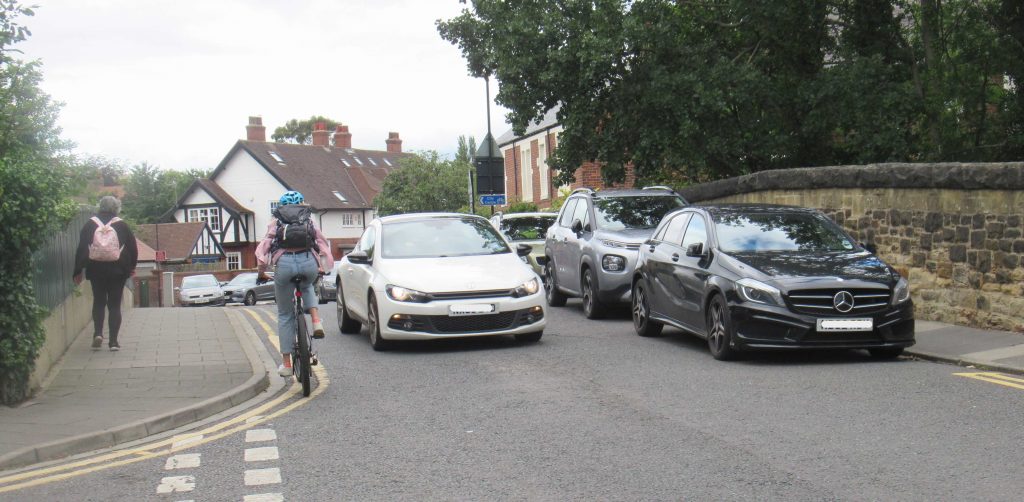
Stoneyhurst Road, next to South Gosforth First School.
Newcastle City Council has announced plans, as part of its Covid-19 response, to close five local bridges to through traffic, so they can be used in safety by people who don’t currently feel comfortable walking or cycling because of the volume of traffic.
Three of these bridges, Salters Bridge, Stoneyhurst Road and Castle Farm Road, are in Gosforth. All three currently experience high levels of traffic even though they are not part of the main road network, and all three have long-term road safety concerns despite calming measures having been put in place.
The three Gosforth bridges also have significant potential to enable people to walk or cycle local journeys travelling east to west or vice versa across the Ouseburn, where currently there are very few safe options. This includes routes to The Freeman Hospital, Benton Park View Government offices and St Mary’s High School.
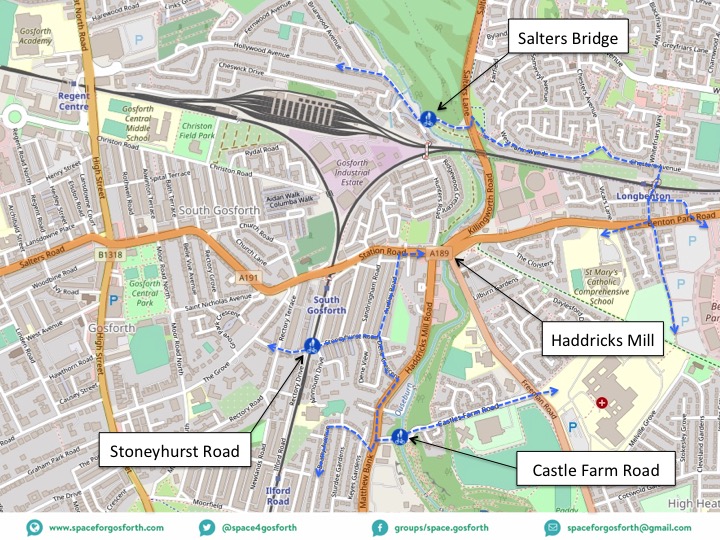
Map showing where roads will be closed to through traffic and walking / cycling routes that have been made safer as a result. The main road network is shown shaded orange.
Change is required urgently, both under the terms of the emergency funding being provided by Government, but also because public transport capacity is significantly reduced due to social distancing and likely to stay that way for the foreseeable future.
The aim is to give people who would have used the bus or Metro, including those that don’t have access to a car, a safe alternative option so public transport can still be used by those that need it most, including key workers, older people and people with disabilities.
This also helps mitigate the risk that more people will drive because they can’t use public transport, which would lead to increased traffic, delays and potentially more air pollution. It is especially important to enable more walking and cycling now to ensure air pollution does not go back up as there is compelling evidence that air pollution is linked to significant increases in Covid-19 infections, hospital admissions and deaths. Doctors are also advising people to take exercise to help reduce their chances of becoming severely ill from Covid-19.
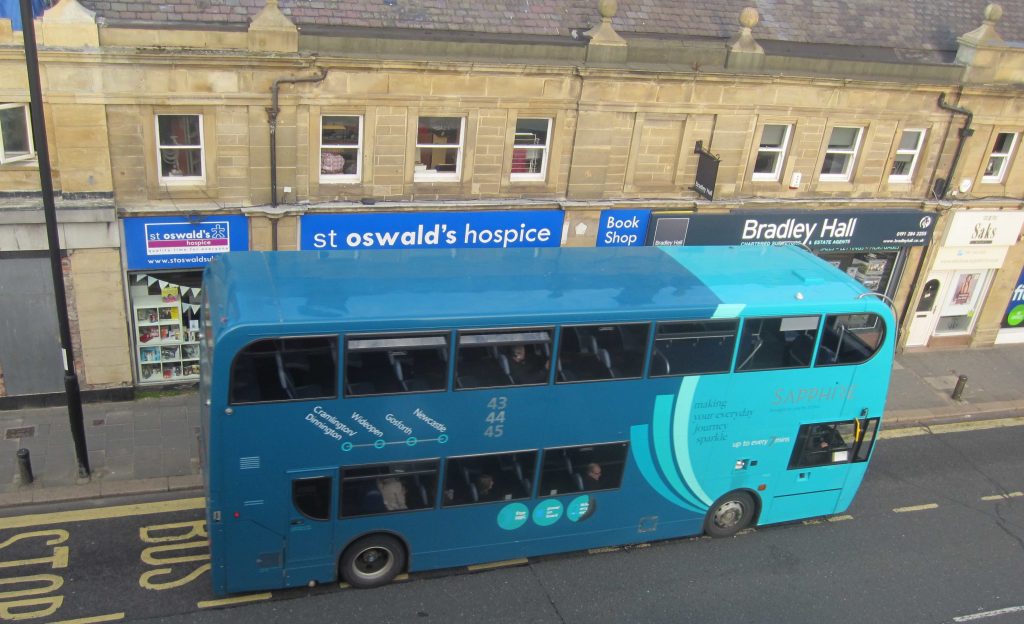
Bus and Metro capacity are substantially reduced due to Covid-19.
This is important context as, for all the inevitable (and most likely incorrect) predictions of traffic chaos, the consequences of not making these changes would most likely be substantially worse, with the biggest negative impact being felt by those that rely on public transport and those that need to drive, whether for work, health or any other reason.
The rest of this blog takes the form of a Frequently Asked Questions (FAQ) about these changes. As ever, where we present evidence we’ll link to original sources so if you want to take a deeper look you can. Please feel free to ask further questions, or suggest other topics for the FAQ in the comments section below.
1. How can I have a say?
Under normal circumstances there would be a consultation in advance of the changes being implemented, but this isn’t possible due to the urgent need to provide alternatives to public transport while also minimising air pollution.
Instead, the Council are using what is called an Experimental Traffic Regulation Order. This means that while the Council intends for the changes to be permanent, it will consult with residents before making a final decision. The Council will announce how to provide feedback once the changes have been made.
This “try before you buy” approach is one we have long supported for a number of reasons.
- Where there are known issues (in this case cuts in public transport capacity) it enables benefits to be achieved much more quickly. Issues could also include cutting air pollution, giving people a greater choice in how to travel, or making it safer for children to travel to school.
- It is much easier for people to understand what is proposed if they can see it on the ground, rather than having to interpret from text on a website or engineering drawings.
- It shows what the effects will actually be, rather than just what people (or the Council) believe the effects could be, and allows any issues to be resolved prior to the scheme being made permanent.
- It increases engagement substantially compared to a newsletter or social media post, as people are much more likely to notice something that has actually changed.
The combination of these – clearer understanding, more engagement and better feedback – should ultimately lead to a better quality scheme for the benefit of local residents achieved much more quickly.
Clearly people will be concerned about the impact and the Council should provide information to address those concerns. Studies have shown though that reallocating road space to enable people to walk or cycle, as the Government has instructed, is rarely as disruptive as people imagine but does create significant benefits for local communities.
The Council has previously consulted on Salters Bridge and more generally on how to improve walking and cycling routes across the City. All three locations were highlighted by local residents as places where they didn’t feel safe to walk or cycle.
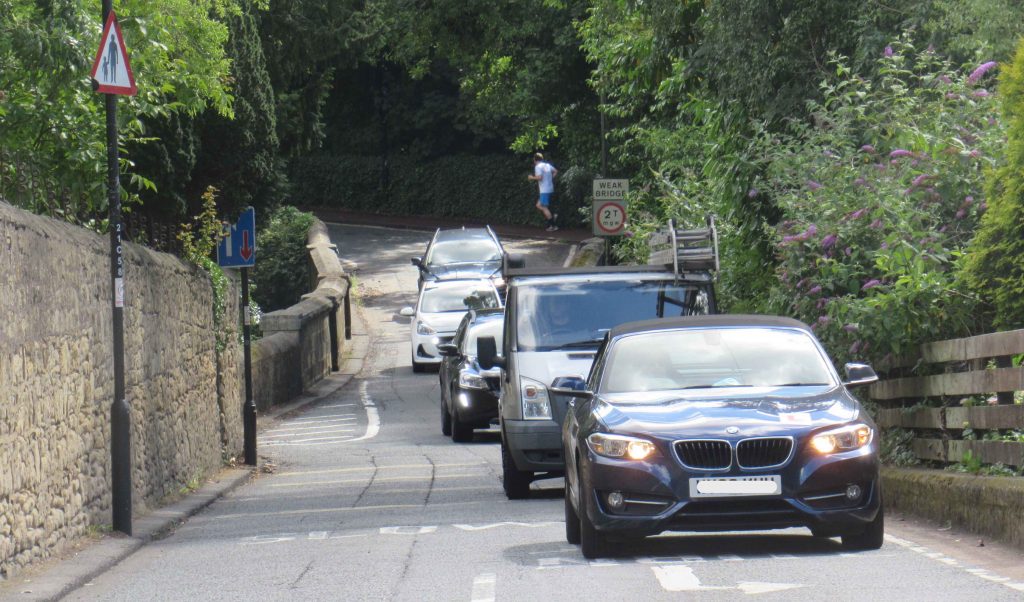
Traffic queue, and no pavements, at Castle Farm Road. Treacherous if walking or cycling, especially after dark.
2. Are there any other benefits?
There are many health, travel and economic benefits of making it easier for people to walk or cycle, not least that they help reduce the overall burden on the NHS at a time when capacity might still be needed for a second peak of Covid-19.
While many of us in stable jobs won’t have felt the full impact, Covid-19 has already led to a significant contraction in the economy and potentially millions of jobs could be lost. Walking and cycling schemes give people a choice to travel more cheaply for local journeys (equivalent to a 8% pay increase compared to driving) and access employment opportunities that would otherwise be unavailable, and are a highly effective way of generating new jobs.
Removing through traffic from these bridges should also help reduce the Council’s maintenance liability at a time when finances are already stretched, as bridges, especially older bridges, will be more expensive to maintain than a normal section of road.
For people living near these bridges or on connecting routes, our expectation is this change should lead to quieter, safer local streets. Stopping through traffic in residential areas is also a necessary first step for anyone who wants to see improvements on nearby main roads to make them safer for local residents.
Streets with less traffic have also been shown to be nicer, more neighbourly places to live, as explained in the video below.
3. How will emergency services be affected?
Emergency services have already been consulted and have confirmed they have no concerns with these proposals.
Making these changes will help avoid the gridlock that could be caused if public transport users have to drive instead through lack of alternative options. Avoiding that scenario will be essential to allow emergency services to continue to operate effectively.
In more normal times, when low traffic neighbourhoods were implemented in Waltham Forest in London prior to Covid-19, the evidence is that emergency response times did not substantially change.
Similar arrangements have already been implemented closer to home, including in Kenton, Heaton, Jesmond and in parts of Gosforth with the agreement of Emergency Services. All these streets are very quiet, liveable streets that would be busy with traffic were it not for a few bollards. The picture below shows some examples.
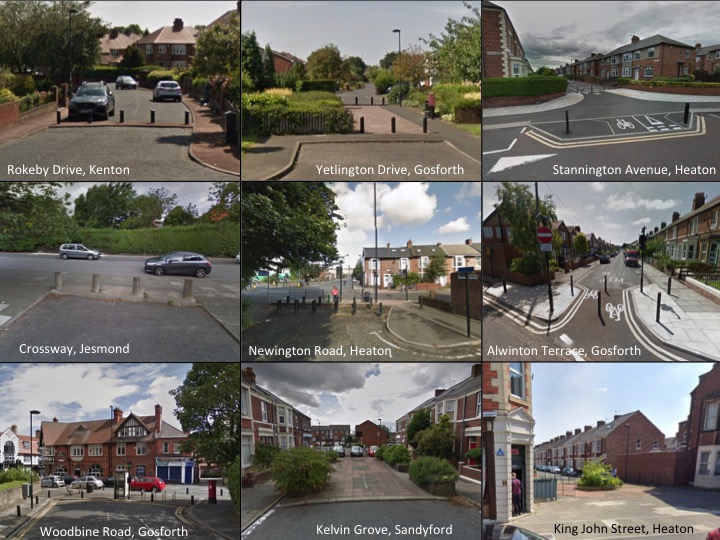
Existing “modal filters” in Newcastle, allowing walking and cycling but not allowing cars or other vehicles.
Enabling more people to walk or cycle also helps get people out of cars that potentially could hold up emergency services vehicles.
Although it is unlikely to be necessary, roads that are closed to motor traffic can be designed to allow continued use by emergency vehicles e.g. through the use of gates, or moveable bollards.
4. What if I need to use a car?
Vehicle access is retained for all properties and if driving you will be able to access the main road network for longer journeys.
These changes are intended to help keep the roads clearer for people who need to drive by enabling more people to leave their car at home and walk or cycle instead.
While some journeys require a vehicle, many don’t. The Department for Transport says that 42% of all journeys are under 2 miles. Many of those could be walked or cycled. A further 25% are between 2 and 5 miles and could easily be cycled by most people if good quality routes are available.
Good quality routes would also help disabled cyclists. Transport for London estimated that 15% of disabled people in London actively cycled for transport in 2014, and groups like Wheels for Wellbeing are actively campaigning for better cycling routes to enable disabled people to cycle. SPACE for Gosforth has assessed local cycling routes for inclusive cycling.
5. How will this impact journey times?
Some journeys might be slightly quicker or slightly slower as a result. Quicker journeys might include:
- Anyone travelling by car north, south or west from Garden Village will benefit because queues to exit Hollywood Avenue will be shorter.
- Even journeys travelling east by car could be quicker as in the words of one resident “If I wanted to reverse off my drive, it could take me 10-15 minutes to actually get out.“
- For the same reason anyone using the number 33 bus will benefit because it will no longer be held up in traffic on Hollywood Avenue.
- People walking or cycling may be able to take faster, more direct routes as a result of the changes rather than longer detours to avoid busy roads.
- Some new cycling journeys might now be possible where previously they were not. Journeys of up to about two miles are frequently quicker by bike, especially in rush hour and when there is cycle parking close to your destination.
- Parents might also save time if quieter streets mean their children can travel independently rather than needing to be escorted due to traffic danger.
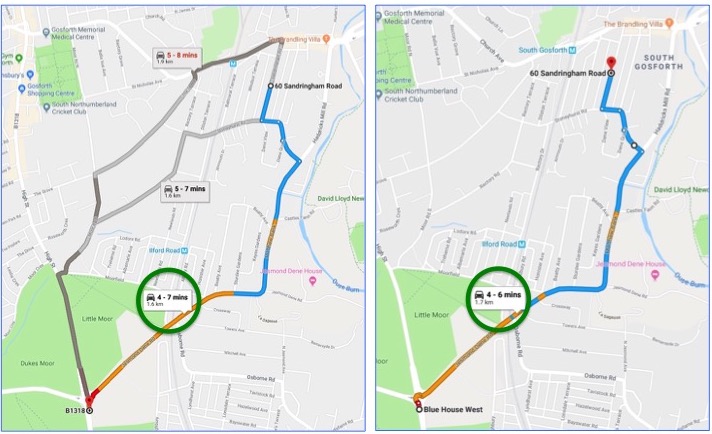
Google Maps journey times from Sandringham Road to Blue House roundabout showing the quickest driving route via Haddricks Mill Road
Some people may prefer to walk or cycle for some journeys even if it takes slightly longer than driving, to save money compared to driving or to get a bit of fresh air and light exercise. This might save time compared to driving somewhere and then doing separate exercise.
You may also want to try dividing your cost of travel (bus tickets, or the cost of buying and running a car) by the amount you are paid per hour, to work out the time it takes to earn that amount, which arguably should be part of any calculation of how much time is needed to travel somewhere.
Travel time = journey time + time to earn money to pay for travel.
The concept of “Effective Speed” goes even further, taking into account a wide range of time costs including for example time to fill a car with petrol or to arrange maintenance.
6. Will this lead to more traffic and pollution at South Gosforth?
A frequent concern when residential streets are closed for through traffic is that the displaced traffic will make nearby main roads more congested. In practice, although there will inevitably be a period of adjustment, it is unlikely to make much difference.
When both Killingworth Road and Salters Bridge were shut traffic levels did not change much on Station Road. Pollution measured by Haddricks Mill roundabout actually reduced quite considerably, and measurements in Longbenton also showed a slight decrease.

The graph below, showing traffic volumes on Station Road has been updated since our blog Roadworks, Air Quality and Disappearing Traffic to add measurements from 2018. We understand there is a perception that traffic increased in 2017 after the start of the Killingworth Road roadworks. This may be because traffic levels were actually suppressed during 2016 due to roadworks at the Salters Road / Great North Road junction.
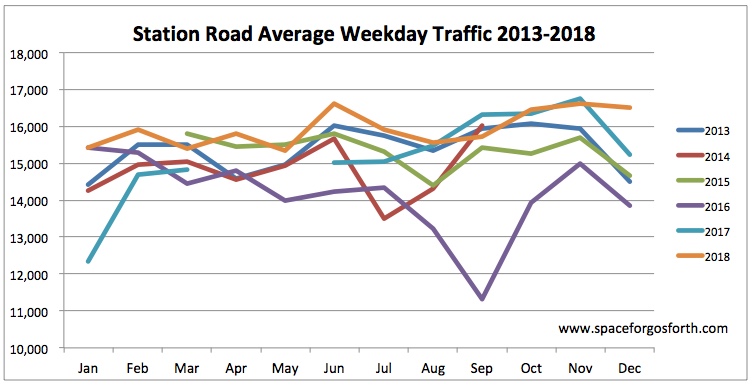
When Killingworth Road closed for road works, many people predicted that a large proportion of the 17,000 vehicles using Killingworth Road would re-route to the Great North Road. In fact traffic volumes on the Great North Road measured by Gosforth Academy were actually lower during the period when Killingworth Road was closed than before.
That’s not to say that traffic levels won’t change. There’s a natural variation from year to year under normal circumstances, and lack of public transport capacity is likely to have an effect as is (in the opposite direction) more people working from home.
7. Will this fix dangerous driving on Hollywood Avenue?
Shortly after Salters Bridge was re-opened to through traffic in October 2019, the Council installed measuring equipment that found that the number of vehicles using the bridge had risen to 4,500 every day of which approximately 2,600 (18,200 per week) were exceeding the speed limit – set at 20mph to ensure the safety of people walking and cycling. They also found that around 1,000 vehicles per week were breaking the three tonne weight limit on Salters Bridge.
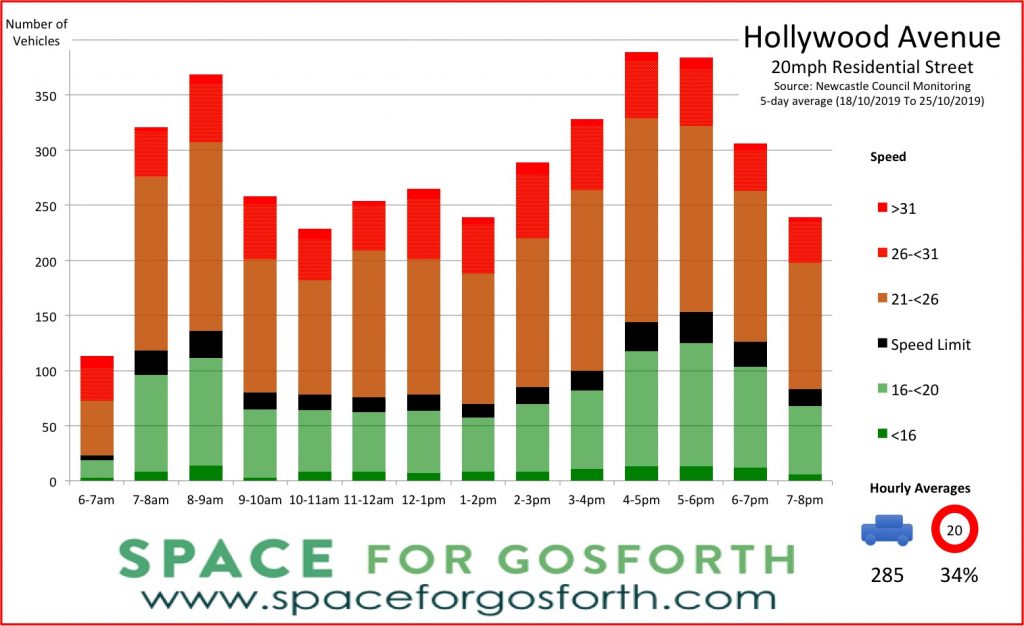
This is substantially less than previous measurements. In 2008, the Council measured over 8,000 vehicles a day using Hollywood Avenue. Possibly the lower number in October reflected the fact that the bridge had only just been re-opened and traffic had not then built back up to previous volumes.
While it’s not possible to completely eliminate dangerous driving, residents reported during the closure for Killingworth Road that it was a safer, quieter, nicer place to live. Certainly the change proposed will stop the street being used by the 1000 heavy vehicles per week that ignored the Salters Bridge weight limit.

A large truck crosses Salters Bridge.
For more on current Hollywood Avenue road safety issues, take a look at the @WeLoveSalters twitter feed.
8. Will more people walk and cycle?
Already, due to less traffic in the Covid-19 lockdown, people are walking and cycling more.
“The number of employees joining the Cycle to Work scheme has more than doubled“, “year-on-year sales of new bikes between £400 and £1,000 more than doubled in April”
Government surveys report that “for distances of 1–2 miles over 60% of journeys were made by motor vehicle” and (via the British Social Attitudes Survey) that 10% strongly agree that “Many of the journeys of less than 2 miles that I now make by car I could just as easily walk” and that 38% agree or strongly agree that “Many of the journeys of less than 2 miles that I now make by car I could just as easily cycle.” The same survey also shows that 62% agree or strongly agree that “It is too dangerous for me to cycle on the roads”.
A recent YouGov survey found that 65% of people said they wanted streets redesigned to protect pedestrians and cyclists and that 51% would cycle more if this happened, while 33% said they would drive less if street layouts were changed.
This all suggests that many people are willing to change how they travel, if only the roads can be made safer for them to do so. Research on similar changes made in London shows that this isn’t just talk and people actually will change how they travel. After one year, people living in parts of London boroughs where changes were made were, on average, walking and cycling for 41 minutes a week more than those living in comparable areas.
To achieve a similar result to those measured in London might require further changes, such as in the example proposals we have previously described for east Gosforth, but these are a step in the right direction.
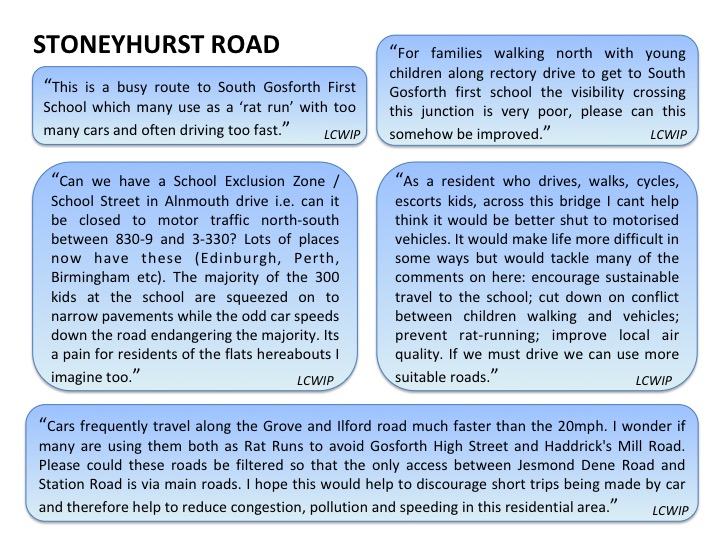
Residents’ feedback about Stoneyhurst Road provided to Newcastle City Council as part of its Local Cycling and Walking infrastructure plan (LCWIP) consultation
9. Will there be an economic impact?
Investing in walking and cycling is generally good for local economies. Our blog Can protected cycle lanes be good for business? looks at the evidence.
If people save money in how they travel, that’s more money that can be spent instead in local shops and cafes.
10. What about the weather?
Newcastle is one of the driest cities in the UK, and has a relatively mild climate ideal for walking and cycling. In our blog It’s not Amsterdam – it doesn’t rain as much for a start! we compared Newcastle’s weather to famous cycling cities Amsterdam and Copenhagen which are respectively wetter and colder than Newcastle.
The other two bridges are Haldane Bridge in Jesmond and Argyle Street Bridge in Ouseburn ward. You can read the Council’s news article here.

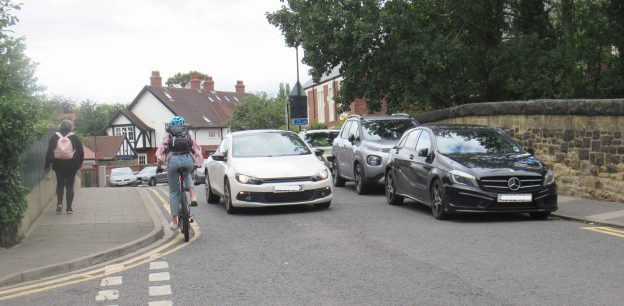
Our families have lived at Scott’s House Farm on Salters Lane for over 100 years and have used Hollywood Avenue all our lives. You have now made our “Lane” into a dual carriageway and put a 50 sign right outside our driveway. Many of the cyclists were EarPods to listen to their music while cycling past our driveway unaware that we drive out. The abuse we are receiving is unbelievable and the motorbikes now go to the bet roundabout so they can belt up and down at speeds well over 50 mph. No thought what so ever has been put into this road and after 2 years of being shut off from everywhere perhaps you may want to put a little bit of thought into the lives of the residents of Salters Lane?
Hi – and thanks for your comment.
Salters Lane was turned into a dual carriageway by North Tyneside Council. If you have complaints about what they have done it would be best addressed to them. Certainly we would agree about the need to reduce dangerous speeding. Perhaps you could also contact Northumbria Police if you haven’t already?
Your point about behaviours I can’t really comment on as I don’t know specifics but generally in the highway code it is for the person entering or exiting a driveway to give way to passing traffic, whether that is people walking, cycling or driving.
I’ve also done a quick google maps directions search from where you live to the junction of Broadway West to Kingston Park Road. It suggests the quickest driving route is via Haddricks Mill taking 9 minutes. Driving via Hollywood Avenue is 10 minutes. Cycling via Heathery Lane is 11 minutes. Routes north, south and east aren’t changing and Killingworth Road roadworks are complete so you might even find journeys by car are quicker in future if you have previously been using Hollywood Avenue?
Funny that I did the same and it’s 6 minutes Via Hollywood Avenue and 9 minutes via South Gosforth. Maybe you just made a mistake . And that’s with no traffic
Hi James, No mistake. I’ve just emailed you the screenshot so you can see for yourself.
It’s probably fair to expect it will vary a bit. I’ve just tried it again now (7am Saturday morning so I presume no traffic) and it’s saying 7 minutes for both, and that’s with Haddricks Mill roadworks still in place.
That’s a totally rubbish idea and it will put extra burden on residents who have cars and live near the South Gosforth School. Stoneyhurst Bridge and surrounding roads have been always used by local residents as their parking – making them very dangerous for driver to get back home. The careless parking on the bridge and surrounding roads leads to congestion too.
Closing the Stoneyhurst Bridge will only benefit residents who live next to the bridge, as they will use it as their parking. So, parking on bridge and within 10 metre of any intersection should be banned first to reduce congestion and improve driving condition. Also a one-way system should be adopted for Stoneyhurst Bridge and surrounding roads (Balmoral, Audley, Windsor, Sandringham, Ilford Road) to cut down traffic to half.
Thanks for the comment. It’s a fairly obvious point but if it is very dangerous for drivers (as you say) enclosed in a hi tech vehicle with anti-crash devices, then it must be much worse for children and families walking who have to cross that road, and will exclude a lot of people from cycling. Protecting other people from harm shouldn’t be seen as a burden. It’s a basic responsibility of any decent society.
The one-way system is an interesting idea but is unlikely to cut the number of vehicles using the street.
This comment was made on the Inclusive Cycling blog but has been re-pasted here as we believe it is a response to this blog.
——-
Hello.
I cannot ride a bike so I sit on the back of the tandem. My husband & I have travelled many times along Stoneyhurst Rd to West Jesmond to dance. We have never had a problem on Stoneyhurst Rd or on Stoneyhurst Bridge as it is wide enough for everyone. The roads beyond are also fine when following the cycle arrows.
Why would anyone want to close this bridge?
I have an 88 year old friend in Sandringham Rd who cannot walk far so he has a car. This allows him to go to Northumberland from time to time to have some fresh air outside the area. He would NOT be able to go there on a bike.
Would you deny him this simple pleasure?
I have another friend who is disabled in the same street so she needs a taxi as she cannot walk far. Both are very upset by the thought of Stoneyhurst Rd Bridge being closed to cars as it offers easy access to the doctor’s in the Grove, Northumberland and many other places. They are both concerned about being stopped from using the traffic lights from the Grove to Church Road as the exits from Sandringham, Audley or Windsor are not the safest ways to get out of the area as they are single track.
Worse still, the exit onto Haddrick’s Mill Rd from Dene Crescent is lethal in winter even with the grit box. Haddrick’s Mill Road is a fast road where turning right is positively dangerous.
Would you want either of them to risk their lives in this way?
My friend who is disabled has a limited budget & could be housebound if the taxi cannot travel directly to the doctor’s as potentially the fare will be higher as the taxi sits in a traffic jam in Sandringham Rd caused by the closure of the Stoneyhurst Rd Bridge.
Would you deny her the use of a taxi at an affordable amount to get to the doctor’s or to facilities in Gosforth?
Are you really so selfish that you cannot see that there is “room for everyone” on tStoneyhurst Road Bridge?
Moreover, you have been misinformed about the effect of more traffic using Audley, Sandringham, Windsor & Balmoral. Queues will cause pollution to my friends in these streets. Is that what you want?
The Stoneyhurst Bridge plan has been executed in a very underhand way with NO CONSULTATION whatsoever except with a select group of cyclists.
I hasten to add that if my husband is unavailable to take me on the tandem, I will have to walk or catch the metro or bus. I am happy to do this as I am fit enough at present.
Therefore, I feel that it is selfish & morally indefensible to close a bridge which is a lifeline for many people & allows emergency vehicles to reach our area easily.
As a long time tandem rider, I look forward to your reply. Sue Smith
Dear Sue,
We have looked at and given a view on your concerns in a separate blog here:
https://www.spaceforgosforth.com/stoneyhurst-bridge-review-of-concerns/
You are entitled to your opinion of course. Many would equally say it is selfish, possibly even morally indefensible, to prioritise saving a few minutes on an occasional journey compared to someone else’s health and wellbeing.
Name-calling won’t help anyone though. We’re presenting facts and evidence as a way of having a better more informed discussion. You are free to disagree if you wish of course.
We hope most people will approach the changes with an open mind and weigh up the relative pros and cons once they have experienced the changes for themselves for a few months.
Pingback: Active Travel Academy » The 2020 Active Travel Media Awards – Results and Reflections